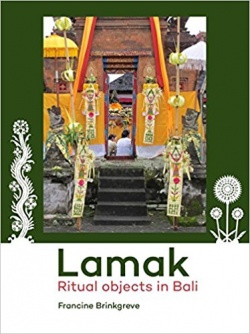- palm leaf mat, usually in the form of a long strip that may be up to several meters in length, decorated with colored cut-outs, and used to decorate many kinds of shrines, such as those used with penjors, or other objects - even automobile grilles when the cars are blessed en
- ron, the leaf of beluluk or sugar palm, or ental, lontar leaf en
- hiasan pura (palinggih) yang terbuat dari janur, bentuknya memanjang ke bawah, dan biasanya dipasang di depan palinggih id
- hiasan penutup dada yang digunakan oleh seorang penari "legong" atau "arja" id

"A lamak is a long narrow ritual hanging that is an essential requirement at almost all rituals in Bali. It is hung from altars and shrines at temple festivals and on festive holy days. Made usually of palm leaves, it is by nature ephemeral and it is made time and again. Even though permanent forms of the lamak, made of cloth or coins, do exist, the ephemeral palm leaf form must be present. Sometimes reaching a length of several metres and decorated with a range of motifs, its most elaborate forms are made by specialist craftsmen and women. The lamak serves as base for offerings and attracts deities and deified ancestors to them. Decorative motifs representing sources of life are ordered according to Balinese concepts of the vertical structure of the cosmos. Best known among the motifs is the cili, a human figure in female form that symbolizes human fertility and regeneration. Through offerings and the active role of the lamak, worshippers offer thanks to their deities and request prosperity and protection.

Lamak (shrine hanging or offering cloth) Bali, Indonesia. Early to mid-20th century. Cotton; handwoven plain weave with supplementary warp patterning. 64 1⁄2 x 15 in. (164 x 38 cm). Division of Anthropology, American Museum of Natural History, Donated by Colin McPhee, 70.2/1153





